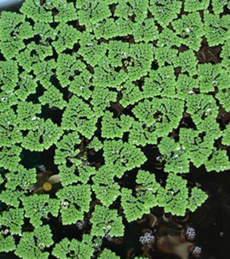Agriculture
The use of biofertilizers, biological systems that supply plant nutrients such as nitrogen to agricultural crops, could reduce agriculture?s dependency on chemical fertilizers, which are often detrimental to the environment.
Plants require an adequate supply of the thirteen mineral nutrients necessary for normal growth and reproduction. These nutrients, which must be supplied by the soil, include both macronutrients (nutrients required in large quantities) and micronutrients (nutrients required in smaller quantities). As plants grow and develop, they remove these essential mineral nutrients from the soil.
Because normal crop production usually requires the removal of plants or plant parts, the nutrients are continuously removed from the soil. Therefore, the long-term agricultural utilization of any soil requires periodic fertilization to replace lost nutrients.
Nitrogen is the plant nutrient that is most often depleted in agricultural soils, and most crops respond to the addition of nitrogen fertilizer by increasing their growth and yield. Therefore, more nitrogen is applied to cropland than any other fertilizer component.
In the past, nitrogen fertilizers have been limited to either manures, which have low levels of nitrogen, or chemical fertilizers, which usually have high levels of nitrogen. However, the excess nitrogen in chemical fertilizers often runs off into nearby waterways, causing a variety of environmental problems.
Less Harmful Alternatives
Biofertilizers offer a potential alternative: They supply sufficient amounts of nitrogen for maximum yields yet have a positive impact on the environment. Biofertilizers generally consist of either naturally occurring or genetically modified microorganisms that improve the physical condition of soil, aid plant growth, or increase crop yield.
Biofertilizers provide an environmentally friendly way to increase plant health and yields with reduced input costs, new products and additional revenues for the agricultural biotechnology industry, and cheaper products for consumers.
Nitrogen Fixing
While biofertilizers could potentially be used to supply a number of different nutrients, most of the interest is focused on nitrogen. The relatively small amounts of nitrogen found in soil come from a variety of sources.
Some nitrogen is present in all organic matter in soil; as this organic matter is degraded by microorganisms, it can be used by plants. A second source of nitrogen is nitrogen fixation, the chemical or biological process of taking nitrogen from the atmosphere and converting it to a form that can be used by plants.
Bacteria such as members of Rhizobium can live symbiotically in the roots of certain plants, such as legumes. Rhizobia and plant root tissue form root nodules, which house the nitrogen-fixing bacteria; once inside the nodules, the bacteria use energy supplied by the plant to convert atmospheric nitrogen to ammonia, which nourishes the plant.
Natural nitrogen can also be supplied by free-living microorganisms, which can fix nitrogen without forming a symbiotic relationship with plants. The primary objective of biofertilizers is to enhance any one or all of these processes.
One of the major goals for the genetic engineering of biofertilizers is to transfer the ability to form nodules and establish effective symbiosis to non-legume plants. The formation of nodules in which the Rhizobia live requires plant cells to synthesize many new proteins, and many of the genes required for the expression of these proteins are not found in the root cells of plants outside the legume family (Fabaceae). If transfer of the appropriate genes could be accomplished, Rhizobia could be used as a biofertilizer for a variety of plants.
There is also much interest in using the free-living, soil-borne organisms that fix atmospheric nitrogen as biofertilizers. These organisms, including types bacteria and algae, live in the rhizosphere (the region of soil in immediate contact with plant roots) or thrive on the surface of the soil.
Because the exudates from these microorganisms contain nitrogen that can be used by plants, increasing their abundance in the soil could reduce the dependency on chemical fertilizers. Numerous research efforts have been designed to identify and enhance the abundance of nitrogen-fixing bacteria in the rhizosphere.
Soil microorganisms primarily depend on soluble root exudates and decomposed organic matter to supply the energy necessary for fixing nitrogen. Hence, there is also an interest in enhancing the biodegradation of organic matter in the soil.
This research has primarily centered on inoculating the soil with cellulose-degrading fungi and nitrogen fixing bacteria or applying organic matter, such as straw that has been treated with a combination of the fungi and bacteria to the soil.
- Fertilizers
FertilizersFertilizers are materials used to modify the chemical composition of soil in order to enhance plant growth. They represent an important use of natural resources because agricultural systems depend upon an ability to retain soil fertility. Soil...
- Microbial Nutrition And Metabolism
Microbial Nutrition and MetabolismThe diverse metabolic activities of microorganisms make them a critical component of all the earth?s ecosystems and a source of many useful products for human industry. Microorganisms?bacteria, fungi, algae, and protists?are...
- Technology Breakthrough: Enables Crops To Take Nitrogen From The Air
A potentially ?world-changing? technology has been developed by researchers at the University of Nottingham ? a means of enabling any type of crop to take nitrogen from the air. In other words, an effective means of phasing out expensive and environmentally...
- The Role Of Nitrogen In Plants
Nitrogen is an essential macronutrient needed by all plants to thrive. It is an important component of many structural, genetic and metabolic compounds in plant cells. It is also one of the basic components of chlorophyll, the compound by which plants...
- Nitrogen Fertilizers Used Off-season Help Crops Planted Later
Nitrogen Fertilizers Used Off-Season Help Crops Planted LaterOct. 7, 2008 ? Combating soil erosion is a primary concern for agricultural producers in the United States, and many have incorporated conservation tillage systems in their effort to maintain...
Agriculture
Biofertilizers
 |
| Biofertilizers |
Plants require an adequate supply of the thirteen mineral nutrients necessary for normal growth and reproduction. These nutrients, which must be supplied by the soil, include both macronutrients (nutrients required in large quantities) and micronutrients (nutrients required in smaller quantities). As plants grow and develop, they remove these essential mineral nutrients from the soil.
Because normal crop production usually requires the removal of plants or plant parts, the nutrients are continuously removed from the soil. Therefore, the long-term agricultural utilization of any soil requires periodic fertilization to replace lost nutrients.
Nitrogen is the plant nutrient that is most often depleted in agricultural soils, and most crops respond to the addition of nitrogen fertilizer by increasing their growth and yield. Therefore, more nitrogen is applied to cropland than any other fertilizer component.
In the past, nitrogen fertilizers have been limited to either manures, which have low levels of nitrogen, or chemical fertilizers, which usually have high levels of nitrogen. However, the excess nitrogen in chemical fertilizers often runs off into nearby waterways, causing a variety of environmental problems.
Less Harmful Alternatives
Biofertilizers offer a potential alternative: They supply sufficient amounts of nitrogen for maximum yields yet have a positive impact on the environment. Biofertilizers generally consist of either naturally occurring or genetically modified microorganisms that improve the physical condition of soil, aid plant growth, or increase crop yield.
Biofertilizers provide an environmentally friendly way to increase plant health and yields with reduced input costs, new products and additional revenues for the agricultural biotechnology industry, and cheaper products for consumers.
Nitrogen Fixing
 |
| Nitrogen Fixing |
Some nitrogen is present in all organic matter in soil; as this organic matter is degraded by microorganisms, it can be used by plants. A second source of nitrogen is nitrogen fixation, the chemical or biological process of taking nitrogen from the atmosphere and converting it to a form that can be used by plants.
Bacteria such as members of Rhizobium can live symbiotically in the roots of certain plants, such as legumes. Rhizobia and plant root tissue form root nodules, which house the nitrogen-fixing bacteria; once inside the nodules, the bacteria use energy supplied by the plant to convert atmospheric nitrogen to ammonia, which nourishes the plant.
Natural nitrogen can also be supplied by free-living microorganisms, which can fix nitrogen without forming a symbiotic relationship with plants. The primary objective of biofertilizers is to enhance any one or all of these processes.
One of the major goals for the genetic engineering of biofertilizers is to transfer the ability to form nodules and establish effective symbiosis to non-legume plants. The formation of nodules in which the Rhizobia live requires plant cells to synthesize many new proteins, and many of the genes required for the expression of these proteins are not found in the root cells of plants outside the legume family (Fabaceae). If transfer of the appropriate genes could be accomplished, Rhizobia could be used as a biofertilizer for a variety of plants.
There is also much interest in using the free-living, soil-borne organisms that fix atmospheric nitrogen as biofertilizers. These organisms, including types bacteria and algae, live in the rhizosphere (the region of soil in immediate contact with plant roots) or thrive on the surface of the soil.
Because the exudates from these microorganisms contain nitrogen that can be used by plants, increasing their abundance in the soil could reduce the dependency on chemical fertilizers. Numerous research efforts have been designed to identify and enhance the abundance of nitrogen-fixing bacteria in the rhizosphere.
Soil microorganisms primarily depend on soluble root exudates and decomposed organic matter to supply the energy necessary for fixing nitrogen. Hence, there is also an interest in enhancing the biodegradation of organic matter in the soil.
This research has primarily centered on inoculating the soil with cellulose-degrading fungi and nitrogen fixing bacteria or applying organic matter, such as straw that has been treated with a combination of the fungi and bacteria to the soil.
 |
| aloevera |
- Fertilizers
FertilizersFertilizers are materials used to modify the chemical composition of soil in order to enhance plant growth. They represent an important use of natural resources because agricultural systems depend upon an ability to retain soil fertility. Soil...
- Microbial Nutrition And Metabolism
Microbial Nutrition and MetabolismThe diverse metabolic activities of microorganisms make them a critical component of all the earth?s ecosystems and a source of many useful products for human industry. Microorganisms?bacteria, fungi, algae, and protists?are...
- Technology Breakthrough: Enables Crops To Take Nitrogen From The Air
A potentially ?world-changing? technology has been developed by researchers at the University of Nottingham ? a means of enabling any type of crop to take nitrogen from the air. In other words, an effective means of phasing out expensive and environmentally...
- The Role Of Nitrogen In Plants
Nitrogen is an essential macronutrient needed by all plants to thrive. It is an important component of many structural, genetic and metabolic compounds in plant cells. It is also one of the basic components of chlorophyll, the compound by which plants...
- Nitrogen Fertilizers Used Off-season Help Crops Planted Later
Nitrogen Fertilizers Used Off-Season Help Crops Planted LaterOct. 7, 2008 ? Combating soil erosion is a primary concern for agricultural producers in the United States, and many have incorporated conservation tillage systems in their effort to maintain...
